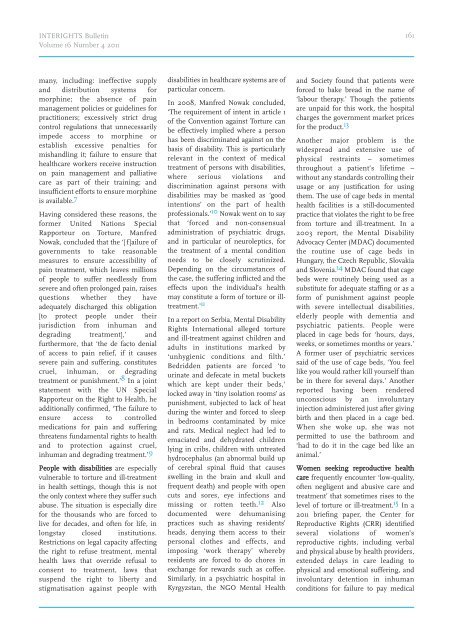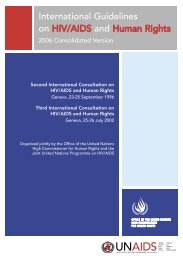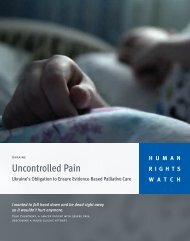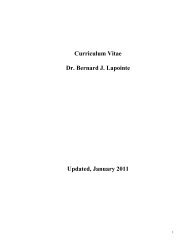INTERIGHTS Bulletin
INTERIGHTS Bulletin
INTERIGHTS Bulletin
You also want an ePaper? Increase the reach of your titles
YUMPU automatically turns print PDFs into web optimized ePapers that Google loves.
<strong>INTERIGHTS</strong> <strong>Bulletin</strong><br />
Volume 16 Number 4 2011<br />
161<br />
many, including: ineffective supply<br />
and distribution systems for<br />
morphine; the absence of pain<br />
management policies or guidelines for<br />
practitioners; excessively strict drug<br />
control regulations that unnecessarily<br />
impede access to morphine or<br />
establish excessive penalties for<br />
mishandling it; failure to ensure that<br />
healthcare workers receive instruction<br />
on pain management and palliative<br />
care as part of their training; and<br />
insufficient efforts to ensure morphine<br />
is available. 7<br />
Having considered these reasons, the<br />
former United Nations Special<br />
Rapporteur on Torture, Manfred<br />
Nowak, concluded that the ‘[ f]ailure of<br />
governments to take reasonable<br />
measures to ensure accessibility of<br />
pain treatment, which leaves millions<br />
of people to suffer needlessly from<br />
severe and often prolonged pain, raises<br />
questions whether they have<br />
adequately discharged this obligation<br />
[to protect people under their<br />
jurisdiction from inhuman and<br />
degrading treatment],’ and<br />
furthermore, that ‘the de facto denial<br />
of access to pain relief, if it causes<br />
severe pain and suffering, constitutes<br />
cruel, inhuman, or degrading<br />
treatment or punishment.’ 8 In a joint<br />
statement with the UN Special<br />
Rapporteur on the Right to Health, he<br />
additionally confirmed, ‘The failure to<br />
ensure access to controlled<br />
medications for pain and suffering<br />
threatens fundamental rights to health<br />
and to protection against cruel,<br />
inhuman and degrading treatment.’ 9<br />
People with disabilities are especially<br />
vulnerable to torture and ill-treatment<br />
in health settings, though this is not<br />
the only context where they suffer such<br />
abuse. The situation is especially dire<br />
for the thousands who are forced to<br />
live for decades, and often for life, in<br />
longstay closed institutions.<br />
Restrictions on legal capacity affecting<br />
the right to refuse treatment, mental<br />
health laws that override refusal to<br />
consent to treatment, laws that<br />
suspend the right to liberty and<br />
stigmatisation against people with<br />
disabilities in healthcare systems are of<br />
particular concern.<br />
In 2008, Manfred Nowak concluded,<br />
‘The requirement of intent in article 1<br />
of the Convention against Torture can<br />
be effectively implied where a person<br />
has been discriminated against on the<br />
basis of disability. This is particularly<br />
relevant in the context of medical<br />
treatment of persons with disabilities,<br />
where serious violations and<br />
discrimination against persons with<br />
disabilities may be masked as ‘good<br />
intentions’ on the part of health<br />
professionals.’ 10 Nowak went on to say<br />
that ‘forced and non-consensual<br />
administration of psychiatric drugs,<br />
and in particular of neuroleptics, for<br />
the treatment of a mental condition<br />
needs to be closely scrutinized.<br />
Depending on the circumstances of<br />
the case, the suffering inflicted and the<br />
effects upon the individual’s health<br />
may constitute a form of torture or illtreatment.’<br />
11<br />
In a report on Serbia, Mental Disability<br />
Rights International alleged torture<br />
and ill-treatment against children and<br />
adults in institutions marked by<br />
‘unhygienic conditions and filth.’<br />
Bedridden patients are forced ‘to<br />
urinate and defecate in metal buckets<br />
which are kept under their beds,’<br />
locked away in ‘tiny isolation rooms’ as<br />
punishment, subjected to lack of heat<br />
during the winter and forced to sleep<br />
in bedrooms contaminated by mice<br />
and rats. Medical neglect had led to<br />
emaciated and dehydrated children<br />
lying in cribs, children with untreated<br />
hydrocephalus (an abnormal build up<br />
of cerebral spinal fluid that causes<br />
swelling in the brain and skull and<br />
frequent death) and people with open<br />
cuts and sores, eye infections and<br />
missing or rotten teeth. 12 Also<br />
documented were dehumanising<br />
practices such as shaving residents’<br />
heads, denying them access to their<br />
personal clothes and effects, and<br />
imposing ‘work therapy’ whereby<br />
residents are forced to do chores in<br />
exchange for rewards such as coffee.<br />
Similarly, in a psychiatric hospital in<br />
Kyrgyzstan, the NGO Mental Health<br />
and Society found that patients were<br />
forced to bake bread in the name of<br />
‘labour therapy.’ Though the patients<br />
are unpaid for this work, the hospital<br />
charges the government market prices<br />
for the product. 13<br />
Another major problem is the<br />
widespread and extensive use of<br />
physical restraints – sometimes<br />
throughout a patient’s lifetime –<br />
without any standards controlling their<br />
usage or any justification for using<br />
them. The use of cage beds in mental<br />
health facilities is a still-documented<br />
practice that violates the right to be free<br />
from torture and ill-treatment. In a<br />
2003 report, the Mental Disability<br />
Advocacy Center (MDAC) documented<br />
the routine use of cage beds in<br />
Hungary, the Czech Republic, Slovakia<br />
and Slovenia. 14 MDAC found that cage<br />
beds were routinely being used as a<br />
substitute for adequate staffing or as a<br />
form of punishment against people<br />
with severe intellectual disabilities,<br />
elderly people with dementia and<br />
psychiatric patients. People were<br />
placed in cage beds for ‘hours, days,<br />
weeks, or sometimes months or years.’<br />
A former user of psychiatric services<br />
said of the use of cage beds, ‘You feel<br />
like you would rather kill yourself than<br />
be in there for several days.’ Another<br />
reported having been rendered<br />
unconscious by an involuntary<br />
injection administered just after giving<br />
birth and then placed in a cage bed.<br />
When she woke up, she was not<br />
permitted to use the bathroom and<br />
‘had to do it in the cage bed like an<br />
animal.’<br />
Women seeking reproductive health<br />
care frequently encounter ‘low-quality,<br />
often negligent and abusive care and<br />
treatment’ that sometimes rises to the<br />
level of torture or ill-treatment. 15 In a<br />
2011 briefing paper, the Center for<br />
Reproductive Rights (CRR) identified<br />
several violations of women’s<br />
reproductive rights, including verbal<br />
and physical abuse by health providers,<br />
extended delays in care leading to<br />
physical and emotional suffering, and<br />
involuntary detention in inhuman<br />
conditions for failure to pay medical
















